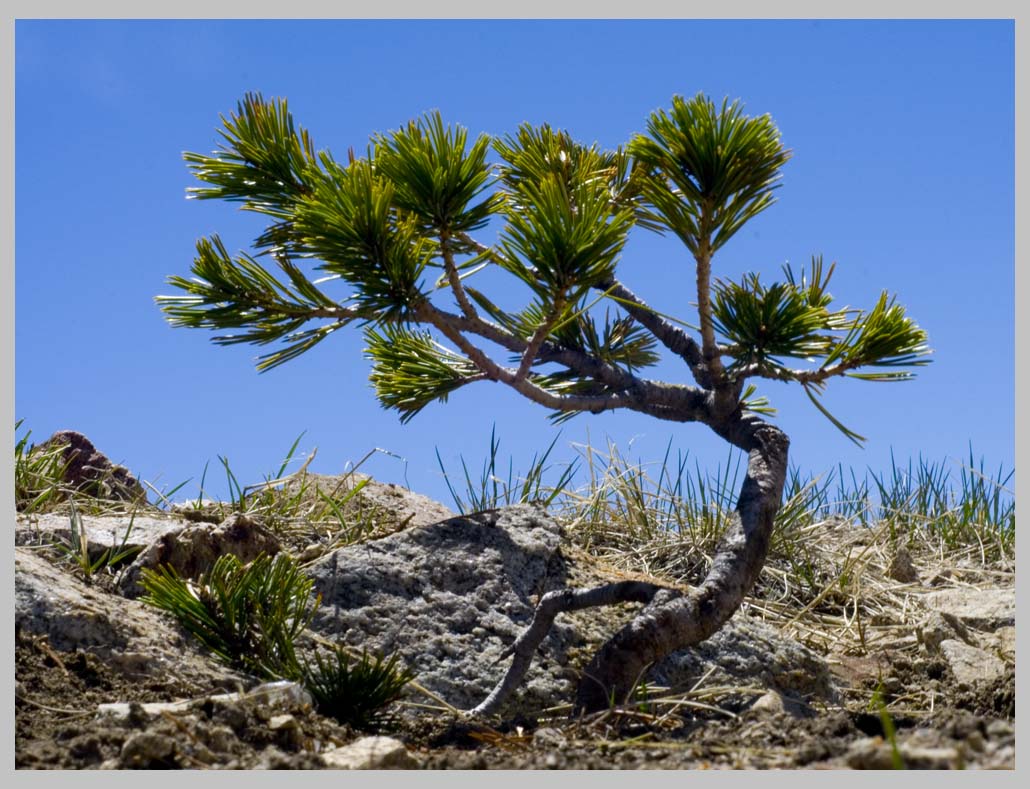

WHITEBARK PINE seedling at TREELINE,
2600 m, Eagle Cap Wilderness, Oregon [ click photo for next . . . ]


WHITEBARK PINE seedling at TREELINE,
2600 m, Eagle Cap Wilderness, Oregon [ click photo for next . . . ]
Whitebark Pines are in trouble around the mountains
of the Northwest. For me, they have become a sentinel species
because they are not only the grandest and, in my view, most
beautiful of pines to reach the upper limits of treeline—even
in death the sun-bleached white snags stand tall for centuries—
but also, like wounded watchful elders, these Nestors of the
high-country are sounding a dire message of warning.
This p/p DIALOGUE RESOURCE PAGE is a gathering together
of films that might help us listen to what the Whitebarks are saying.
It is also a kind of mirror of ourselves, as we reflect upon our own
response to what we see.
| see also my p/p DIALOGUE PAGE: WORLD WITHOUT NUCLEAR |Below is a little meditation on what trees
and forests mean to me . . .
On the road in the American Northwest.
NATURAL BEAUTY is beauty
unaware of itself,
humble, persistent in its growth,
and deeply rooted
were it stands.
THE LITTLE CLAVIER please preview 150 of 631 pages
w/ my black & white photography [opens in new window]
Follow @cliffcrego
ON THE PROTECTION OF TREES
“What a friend we have in a tree.”
Wangari Maathai
Unlike the European Alps, in which the environmental factors of high
altitude, cold and snow limit the growth of coniferous trees and forests,
in the East-side mountains of the American Northwest an additional
factor plays a key role at lower elevations—namely, drought. For the
large and graceful and beautiful trees that are native there, the lack of
reliable yearly amounts of precipitation is just as severely a limiting
factor as the deep snowpack that lingers well into the summer months.
Accordingly, I’ve come to see the great forests of fir, spruce and pine
not so much as static masses of green, but rather as a kind of dynamic,
living movement. The movement is suspended, like a question on a
string, between these two limiting extremes of altitude and drought.
With different amounts of snowfall and rain, or higher or lower mean
temperatures, the forest will respond by moving up, or down, the
mountain; and by expanding or contracting into or away from the dry
plains and arid canyonlands.
In the middle of this movement, it seems to me, stands the great Pon-
derosa Pine. It is the yellow-green ribbon of the arboretum’s rainbow
spectrum in the Oregon forestlands; it is the middle C of the forest’s
frequency scale, the strong, stable triangle between geometry’s circle
and square. Where the ponderosa forms large stands, it takes the happy
middle ground between the colder, more moist preferred habitats of
Douglas-fir, Subalpine Fir and Englemann Spruce, and the little rain and
searing summer heat endured by Juniper and Sage.
One must have an ear for the origin of words to hear consciously the
adjectives, ‘massive’ or ‘ponderous’ in the Ponderosa’s name. And
one must have more than a keen sense of forest history to imagine the
prodigious giants lost to bandsaws and trains. Trains? Yes, in Northeast-
ern Oregon, whole tracks were built for the sole purpose of carrying the
trees away. In the North Wallowas, already by 1926, few of the grand
old ponderosas were left, and the tracks constructed for their wholesale
plunder from Minam to Enterprise are now but a footnote for Sunday
tourists. And as with all natural destruction, who is left with first-hand,
direct experience to speak to the children about the grandeur that has
been lost? Field biologists will tell you that it is now difficult to find
suitable stands of old-growth ponderosa—reduced in a mere three of
four generations to but 3% of their former area—simply for study and
comparison purposes
I frequently remind myself, speaking with Chinese poet, “If one wants
to know the ponderosa, go to the ponderosa.” And sacred ground it is.
No better place to camp. No better place to build a home. And no bet-
ter place to discover a new creative spirit which takes as its epithet not
‘man the destroyer,’ but ‘man the creator,’ the generator of new habitats
for the whole web of the symphony of life.
Featured gallery, mountain water . . . .Please visit my MOUNTAIN Water Gallery—some of
the best of my flowform photography w/ a selection of the highest quality
prints & frames . . . [ mouse over for controls / lower right fro full-screen ]
All Photographs & texts by Cliff Crego © 2012 picture-poems.com
(created: VIII.10.2012)